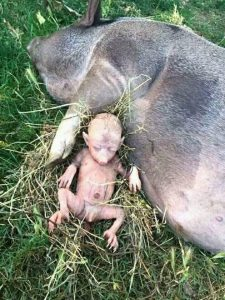
“Half Pig, Half Human?” — The Truth Behind the Viral Creature That Shocked the Internet
If you’ve spent even five minutes online recently, chances are you’ve stumbled across the bizarre and unsettling photo of what looks like a baby born half pig, half human. The creature, pink and hairless, with eerily human-like features but a pig snout and claws, has sparked a storm of speculation. Is it a science experiment gone wrong? A genetic mutation? A Photoshop hoax? Or — as some corners of the internet suggest — evidence of some secret hybrid program?
Let’s take a breath, put on our rational thinking caps, and get to the bottom of this curiosity with a little science, a little humor, and a healthy dose of common sense.
What Are We Actually Looking At?
The creature in the image is most likely a newborn piglet with a congenital defect — something far more common (and less otherworldly) than many people think. Piglets, like all mammals, can be born with a variety of deformities, particularly if the mother is malnourished, exposed to toxins, or suffers from infections during pregnancy.
In veterinary science, such anomalies are referred to as teratogenic deformities. These can result in malformed snouts, extra limbs, cleft palates, and sometimes even oddly shaped skulls that resemble human features.
So… Is It Part Human?
Absolutely not.
Let’s be clear: there’s no such thing as a natural “half-pig, half-human” hybrid. Human DNA and pig DNA are not compatible for natural reproduction. While humans and pigs do share a surprising amount of genetic similarity (around 98%, according to the National Institutes of Health), this does not mean the two species can crossbreed. Biology doesn’t work that way — thankfully.
In fact, even under the most advanced laboratory conditions, scientists have only just begun to explore the possibility of growing human organs in pigs (a field known as xenotransplantation), and even those attempts are extremely controlled, ethical, and monitored by multiple regulatory bodies. No one’s out here making pig-human hybrids in their backyard — or their barn.
Why Does It Look So Human, Though?
This isn’t the first time a piglet has gone viral for looking disturbingly human. In 2017, a deformed piglet born in the Philippines shocked villagers and went viral for its “baby-like” face. In nearly every case, veterinary experts explained the phenomenon as cyclopia (a rare congenital condition where the skull doesn’t form properly), or other craniofacial deformities. The resulting features can eerily resemble human traits — but it’s purely coincidental.
Also, consider this: humans are wired to see faces in random patterns — a psychological phenomenon known as pareidolia. That’s why we see Jesus in a grilled cheese sandwich or think this piglet looks like your Uncle Larry.
But Why Do People Believe It?
Let’s face it — we love a good story. And nothing grabs attention like the grotesque, the mysterious, and the impossible. It’s the same reason why stories of Bigfoot, chupacabras, or alien babies gain traction online. It taps into our curiosity, fear, and fascination with the unknown.
Plus, in today’s world of AI-generated images, deepfakes, and Photoshop, it’s getting harder and harder to separate fact from fiction. That’s why it’s so important to ask: Where did this image come from? Who shared it first? Has any reputable news outlet or scientific authority commented on it?
In this case, there’s no official report, no veterinary confirmation, and no traceable origin — all signs that this is either a hoax, a misunderstood medical anomaly, or a deliberate attempt at viral misinformation.
Final Thoughts: Stranger Than Fiction, but Still Science
So, while the internet may want to believe this is some kind of Frankenstein monster, the truth is a lot more mundane — and oddly comforting. It’s just biology doing its unpredictable thing. Nature doesn’t always get things right, and sometimes, it results in creatures that look downright uncanny.
But that doesn’t mean we need to reach for science fiction or conspiracy theories.
So next time you see a “half-human, half-something” creature online, take a moment to dig deeper, ask questions, and maybe even share a chuckle. Because at the end of the day, the real world is weird enough — we don’t need hybrids to make it interesting.
Sources:
- National Institutes of Health (NIH) on human-pig genetic research
- American Veterinary Medical Association (AVMA) on congenital deformities in animals
- “Pareidolia: Why We See Faces Everywhere,” Scientific American
Let’s keep our feet — and our snouts — firmly grounded in reality. 🐷